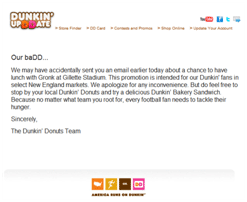You just screwed up a mailing. Your palms sweat and a wave of panic sets in. OMG, what do you do?
Follow US! |
If you have avoided the lightning strike of a mistake, consider yourself lucky for now, but don’t be lulled into thinking it will never happen to you. That lightning bolt is getting closer. This information is even more important for you.
Let’s skip the “you should always test and have a solid QA process before clicking send” lecture and begin when you realize the mistake has occurred. What do you do first?
The Mistake-o-Meter
To the marketer, any mistake is serious, even in cases when the consumer may not notice or be affected. Before making any drastic decisions about how to react to the error, determine the actual severity of the error. While all mistakes are unique and a list of every possible error would be nearly infinite, this scale should help you determine your panic level for the most common errors.
Minor: Might be noticed by the subscriber but does not significantly affect user experience or function of the email.
-Typos in copy
-Misaligned table
Moderate: Likely to be noticed by the subscriber and may moderately affect user experience and functionality of the email. May be fixable.
-Broken image
-Incorrect or broken links
Serious: May not be visually obvious to the subscriber but significantly impacts user experience and/or functionality of the email.
-Incorrect promotional code
-Wrong price or product featured
-Sale hasn’t started / has ended
-Site not functioning
The Reaction
After assessing the severity of the error, asking yourself these two questions can help you determine if an apology email is needed:
-Does the mistake negatively impact the customer experience?
-Will sales severely suffer?
If you answer “yes” to either of these questions, then you should send an apology email. Having a flexible, easy-to -edit template will help you develop an apology email quickly and without the need of your creative team. I recently received this apology email from Dunkin Donuts that uses such a design. The email retains Dunkin Donuts’ branding and navigation, but the primary content area is only text. Keep a template like this one in your arsenal.
Only those who were impacted by the error should receive the apology email. In some cases, you may not be able (or have the time) to identify the affected subscribers, but doing so could help keep the issue contained to a smaller population.
In most cases, apology emails should communicate the following:
-An actual apology and acknowledgement of the error as the primary message.
-Identification of the specific error: “You received an invalid promo code.”
-Solution and resolution time: “Please use this code instead.” “Our site should be back up by 6pm ET.”
And sometimes, depending on the severity of the error, the message should include a make-good offer: “For your inconvenience, please enjoy free shipping today.”
The Fallout
The best efforts to resolve the mistake may not be enough. Even with the best intentions of correcting the mistake and potentially giving those impacted a special offer, there may be customers who want more. Your customer service team and those on the receiving end of your program’s reply-to address should be aware of the mistake and the resolution plan. Customer service should also be prepared to interact with those customers who are still upset. In extreme cases, there could be legal issues to consider. A well-trained team should be able to provide a positive customer service experience and navigate these tricky waters.
Of course, the “you should always test and have a solid QA process before clicking send” rule should be followed to avoid mistakes. But it’s safe to assume that despite all of your best intentions, mistakes will still occur. And when they do, being strategically and emotionally prepared in advance will help you make rational decisions when things are at their most chaotic.
Jim Davidson is manager of marketing research for Bronto Software.

